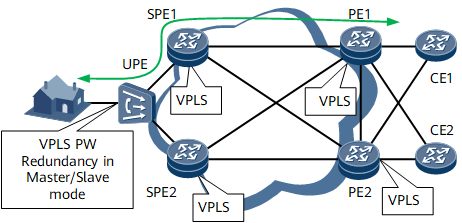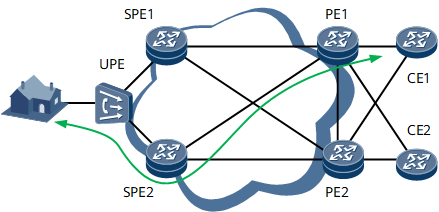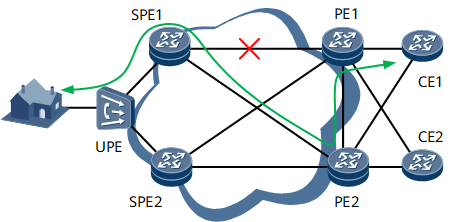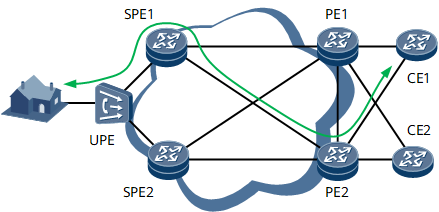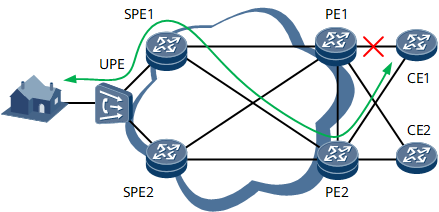VPLS PW Redundancy for Protecting Multicast Services
Figure 1 illustrates an application of VPLS PW redundancy for protecting multicast services, such as Internet Protocol television (IPTV) services, on a hierarchical virtual private LAN service (HVPLS) network.
Multicast sources CE1 and CE2 are each dual-homed to PE1 and PE2 using the E-Trunk mechanism; PEs connect to SPEs over common PWs. A gateway UPE connects the user end to SPEs. The link between the UPE and SPE1 and the link between the UPE and SPE2 back up each other.
In this networking, the UPE must use the master/slave PW redundancy mode because SPE1 and SPE2 do not exchange signaling to determine which one is the master SPE. Upon detecting that the primary PW fails, the UPE rapidly switches traffic to the secondary PW, instructs SPE2 to work as the primary SPE, and sends MAC Withdraw messages to SPE2, instructing SPE2 to delete the MAC addresses learned from SPE1. SPE2 transmits the MAC Withdraw messages to PE1 and PE2, instructing PE1 and PE2 to clear the MAC addresses learned from SPE1. After deleting the MAC addresses learned from SPE1, PE1 will relearn MAC addresses by broadcasting upon receiving multicast traffic from CE1 and CE2 and switch received traffic to the secondary PW.
Figure 1 shows how traffic transmits when no fault occurs. The following describes how VPLS PW redundancy protects traffic after a fault occurs.
Failure of the Primary PW Between the UPE and SPE1
Figure 2 shows how traffic is switched if the primary PW between the UPE and SPE1 fails.
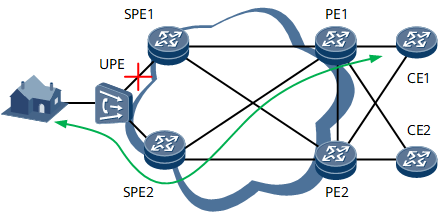
Label switched path (LSP) Down events or BFD for PW may cause a PW to go Down. Upon detecting that the primary PW fails, the UPE switches traffic to the secondary PW and sends MAC Withdraw messages in which the PE ID field carries the SPE1 LSR ID to SPE2. SPE2 transparently transmits the MAC Withdraw messages to PE1 and PE2. Then, SPE2, PE1, and PE2 clear the MAC addresses learned from SPE1.
Switchback: After the primary PW recovers, the UPE instructs SPE2 to change its PW forwarding status to standby and SPE1 to change its PW forwarding status to active. The UPE sends MAC Withdraw messages in which the PE ID field carries the SPE2 LSR ID to SPE1. SPE1 transparently transmits the MAC Withdraw messages to PE1 and PE2. SPE1, PE1, and PE2 clear the MAC addresses learned from SPE2. PE1 and PE2 then relearn MAC addresses by broadcasting upon receiving multicast packets from the primary PW.
SPE1 Failure
Figure 3 shows how traffic is switched if SPE1 fails.
After detecting that SPE1 fails, the UPE switches traffic to the secondary PW and sends MAC Withdraw messages in which the PE ID field carries the SPE1 LSR ID to SPE2. SPE2 transparently transmits the MAC Withdraw messages to PE1 and PE2. Then, SPE2, PE1, and PE2 clear the MAC addresses learned from SPE1. Sometimes, PE1 and PE2 detect that the PW passing through SPE1 is faulty before receiving the MAC Withdraw messages and directly clear the MAC addresses learned from SPE1.
Switchback: After the primary PW recovers, the UPE instructs the PW passing through SPE2 to work as the standby PW and the PW passing through SPE1 to work as the master PW. The UPE sends MAC Withdraw messages in which the PE ID field carries the SPE2 LSR ID to SPE1. SPE1 transparently transmits the MAC Withdraw messages to PE1 and PE2. SPE1, PE1, and PE2 clear the MAC addresses learned from SPE2. PE1 and PE2 then relearn MAC addresses by broadcasting upon receiving multicast packets from the primary PW.
Link Failure Between SPE1 and PE1
Figure 4 shows how traffic is switched if the link between SPE1 and PE1 fails.
If Label Distribution Protocol (LDP) fast reroute (FRR) is deployed on SPE1 and PE1, LDP FRR ensures the availability of traffic between SPE1 and PE1. If LDP FRR is not deployed, the LDP LSP ensures the availability of traffic between SPE1 and PE1 by means of route convergence.
Switchback: Traffic will not be switched between the primary and secondary PWs. After route convergence, the primary PW is carried by a new LSP.
PE1 Failure
Figure 5 shows how traffic is switched if PE1 fails.
CE1 and CE2 are each dual-homed to PE1 and PE2 using the E-Trunk mechanism. If PE1 fails, a master/backup E-Trunk switchover occurs. PE2 detects the AC interface status change and sends MAC Withdraw messages to SPE1 and SPE2, instructing SPE1 and SPE2 to clear MAC addresses in the corresponding VSIs. Sometimes, SPE1 and SPE2 detect that the PW passing through PE1 is faulty before receiving the MAC Withdraw messages and directly clear MAC addresses associated with the PW.
Switchback: If PE1 recovers, traffic switches back to PE1 after a default E-Trunk switchback delay. Upon detecting the AC status changes, PE1 and PE2 send MAC Withdraw messages to SPE1 and SPE2, instructing SPE1 and SPE2 to clear MAC addresses learned from PE2.
Failure of the Primary AC Link
Figure 6 shows how traffic is switched if the link between CE1 and PE1 fails.
CE1 and CE2 are each dual-homed to PE1 and PE2 using the E-Trunk mechanism. After the link between CE1 and PE1 fails, a master/backup E-Trunk switchover occurs. Upon detecting AC interface status changes, PE1 and PE2 send MAC Withdraw messages to SPE1, instructing SPE1 to clear all MAC addresses in the corresponding VSI.
Switchback: After the link between CE1 and PE1 recovers, a master/backup E-Trunk switchback occurs. Upon detecting AC interface status changes, PE1 and PE2 send MAC Withdraw messages to SPE1, instructing SPE1 to clear MAC addresses.
